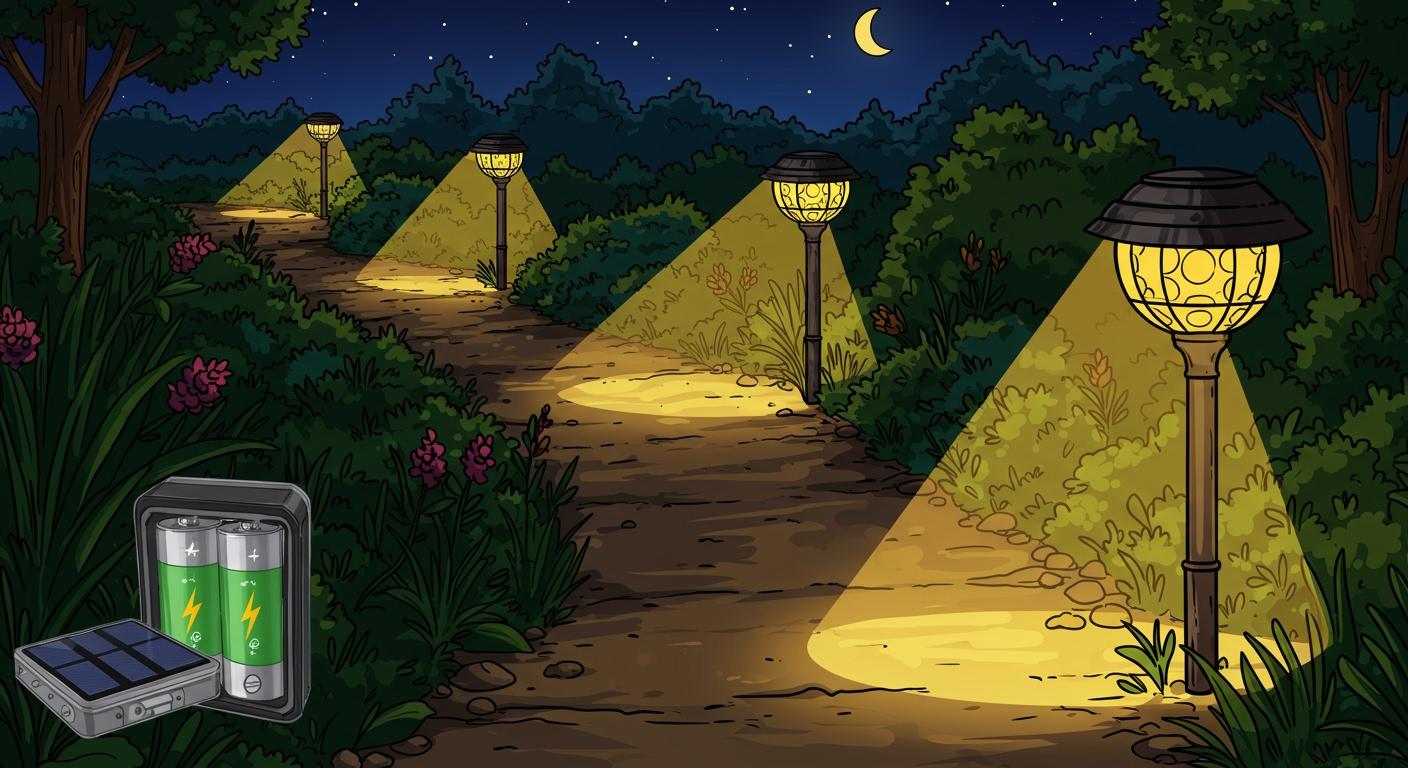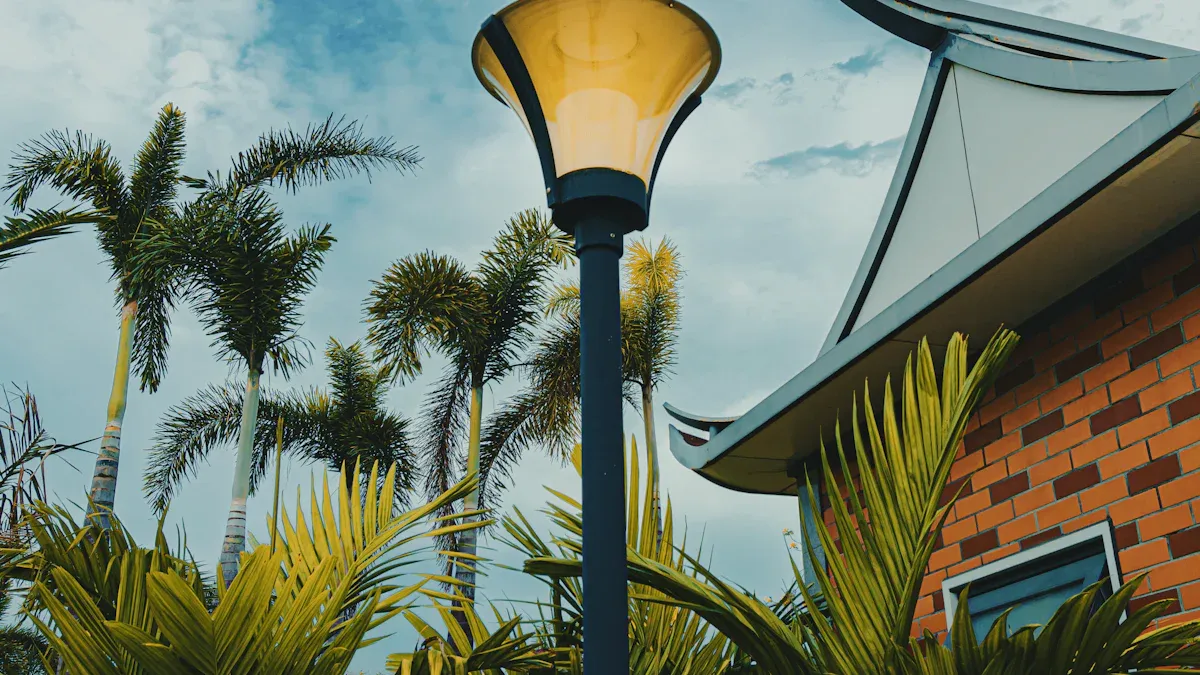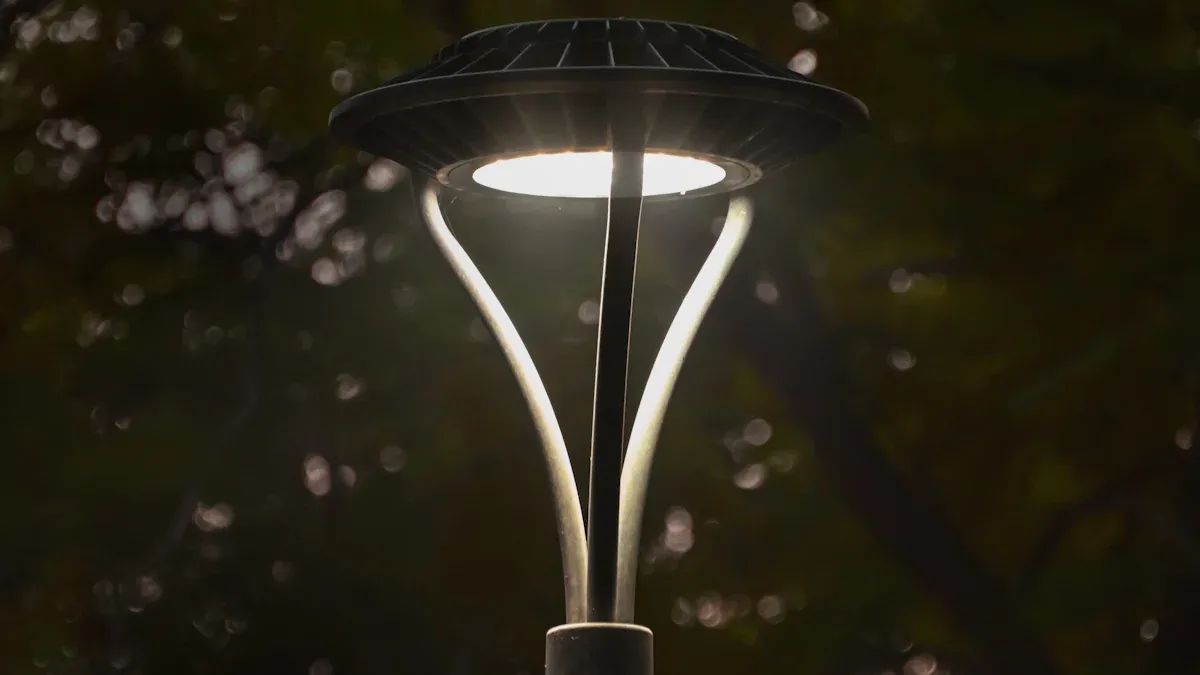
You rely on batteries to keep solar yard lights shining after sunset. During the day, solar panels absorb sunlight and transfer energy to the battery. The charged battery stores this power, then releases it at night to illuminate the LEDs. Batteries Power Solar systems efficiently, but cloudy weather can affect performance.
Key Takeaways
Solar yard lights use batteries to store energy from sunlight during the day. This energy powers the lights at night, ensuring they shine brightly.
High-quality lithium batteries, like LiFePO4, are ideal for solar lights. They last longer and charge faster than other types, providing reliable performance.
Regular maintenance, such as cleaning solar panels and checking battery health, helps extend the life of solar yard lights and keeps them working efficiently.
Part1: Solar Yard Lights Components

Solar yard lights rely on several key components that work together to deliver reliable illumination. Understanding each part helps you see how solar garden lights operate efficiently from day to night.
1.1 Solar Panel
The solar panel is the heart of solar garden lights. You find it mounted on top of the fixture, where it collects sunlight and converts it into electricity. Most solar yard lights use monocrystalline, polycrystalline, or thin-film solar panels. Monocrystalline panels offer the highest efficiency, reaching up to 22%. Polycrystalline panels provide 15-18% efficiency, while thin-film panels reach about 10-12%. The solar panel’s job is to generate enough energy during the day for charging the battery.
Type of Solar Panel | Efficiency Range (%) |
|---|---|
Monocrystalline | 18-22 |
Polycrystalline | 15-18 |
Thin-Film (Amorphous) | 10-12 |
1.2 Battery Pack
The battery pack stores the energy produced by the solar panel. When you use solar garden lights, the battery charges during the day and powers the LEDs at night. Lithium-based batteries, such as LiFePO4 (Lithium Iron Phosphate), NMC (Nickel Manganese Cobalt Oxide), LCO (Lithium Cobalt Oxide), LMO (Lithium Manganese Oxide), LTO (Lithium Titanate), solid-state, and lithium metal batteries, dominate modern solar yard lights due to their high energy density, long cycle life, and stable performance. These chemistries also serve in medical devices, robotics, security systems, infrastructure, consumer electronics, and industrial equipment. Battery management systems (BMS) are essential for safety and efficiency.
Battery Chemistry | Typical Applications | Energy Density (Wh/kg) | Cycle Life (cycles) | Key Features |
|---|---|---|---|---|
LiFePO4 | Medical, Industrial, Security | 90-120 | 2000+ | High safety, long life |
NMC | Robotics, Consumer Electronics | 150-220 | 1000-2000 | High capacity, balanced |
LCO | Consumer Electronics | 150-200 | 500-1000 | High energy, moderate life |
LMO | Power tools, Industrial | 100-150 | 300-700 | High current, moderate life |
LTO | Infrastructure, Medical | 70-80 | 5000+ | Extreme cycle life, safe |
Solid-State | Emerging, All sectors | 250+ | 1000+ | High safety, future tech |
Lithium Metal | R&D, High-end Electronics | 300+ | 500+ | Ultra-high energy, developing |
1.3 LED & Circuit
LEDs (Light Emitting Diodes) provide the light output in solar garden lights. LEDs use very little power but produce bright illumination, making them ideal for solar applications. A typical LED setup in solar yard lights consumes only a few watts, which allows the battery to last through the night. The control circuit, including a photoresistor, manages when the LEDs turn on and off. It senses ambient light and activates the LEDs at dusk. The circuit also protects the battery by regulating charging the battery and discharging, preventing overcharging or deep discharge. This ensures your solar yard lights remain efficient and reliable.
Note: The combination of a high-efficiency solar panel, advanced lithium battery pack, and smart control circuit allows solar garden lights to deliver consistent performance with minimal maintenance.
Part2: Batteries Power Solar at Night

2.1 Daytime Charging
You see solar garden lights working because of the way solar panels collect energy during the day. Solar panels use the photovoltaic effect to convert sunlight into electricity. When photons from sunlight hit the semiconductor material in the panel, electrons get excited and move, creating an electric current. This current flows through wires and charges the rechargeable battery inside the solar yard lights.
Solar panels convert sunlight into direct current (DC) electricity.
The generated electricity charges the rechargeable battery during peak sunlight hours.
The battery stores extra solar energy for use at night or during cloudy periods.
A standard 400W solar panel can produce about 1,800 Watt-hours of DC electricity in a typical day. After conversion losses, you get around 1,750 Watt-hours of usable power. This amount is more than enough to keep solar garden lights running through the night.
You need to position solar garden lights in areas with direct sunlight for most of the day. Avoid shaded spots and adjust the angle of the solar panel to match the sun’s path across seasons. Solar yard lights require full sun exposure for 6-8 hours daily for optimal charging. Shading from trees or buildings increases charging times, and cloudy days or winter months reduce the amount of solar energy stored.
Tip: Clean the solar panel regularly to remove dust and moisture. This helps maximize the amount of solar energy collected and improves battery charging efficiency.
2.2 Nighttime Lighting
When night falls, the rechargeable battery takes over and powers the LEDs in your solar garden lights. The control circuit, which includes a photoresistor, senses the drop in light levels. The photo eye detects darkness and automatically switches on the LEDs, ensuring your solar yard lights illuminate the area without manual intervention.
The rechargeable battery supplies power to the LEDs at night.
The control circuit manages the flow of electricity and protects the battery from over-discharge.
A dusk/dawn switch, often using a photoresistor, activates the lights only when needed.
Solar garden lights can stay illuminated for an average of 8.5 hours on a full battery charge. Depending on the battery capacity and sunlight exposure during the day, you may see your lights operate anywhere from 4 to 12 hours each night. The combination of a high-quality rechargeable battery and efficient LEDs ensures reliable performance throughout the night.
Note: The automatic activation feature saves energy and extends battery life by turning the lights on only when darkness is detected.
2.3 Performance Factors
Several factors influence how well batteries power solar garden lights at night. You must consider battery chemistry, environmental conditions, charge controller type, and maintenance practices to optimize performance.
Factor | Impact on Charging Efficiency |
|---|---|
Charge Controller Type | MPPT controllers extract up to 30% more power from solar panels than PWM controllers. |
Battery Characteristics | Lithium-ion batteries charge faster and last longer than lead-acid batteries. |
Environmental Conditions | High temperatures and humidity reduce solar panel efficiency and battery performance. |
Battery Type | Energy Density | Lifespan | Maintenance | Environmental Impact |
|---|---|---|---|---|
LiFePO4 | High | Long | Low | Low |
GEL Cell | Moderate | Moderate | Low | Moderate |
AGM Glass Mat | Moderate | Moderate | Low | Moderate |
Nickel Cadmium (NiCd) | High | Long | Moderate | High |
Lithium battery chemistries, such as LiFePO4, NMC, LCO, LMO, LTO, solid-state, and lithium metal, offer high energy density and long cycle life. LiFePO4 batteries provide excellent safety and longevity, making them ideal for solar garden lights in medical, robotics, security, infrastructure, consumer electronics, and industrial applications. NMC batteries balance capacity and lifespan, while LTO batteries deliver extreme cycle life and safety.
You must also pay attention to environmental factors. High temperatures decrease solar panel efficiency, which reduces the energy available for charging batteries power solar garden lights. For every 1°C increase above 25°C, solar panel efficiency drops by about 0.5%. High humidity causes moisture buildup on panels, lowering efficiency and battery charge. Position solar garden lights in areas with direct sunlight and avoid shaded spots to maximize charging cycles.
Maintenance practices play a key role in extending battery life and ensuring batteries power solar garden lights reliably at night:
Optimize charging parameters according to manufacturer guidelines.
Avoid deep discharges and keep the depth of discharge under 50%.
Regulate temperature and avoid extreme conditions.
Use the battery regularly to prevent capacity loss.
Distribute the load evenly to prevent sudden high power draws.
Store batteries at the recommended state of charge, ideally around 50%.
Keep batteries in a cool, dry place.
Perform regular maintenance checks on battery condition and charge levels.
Reminder: High-quality rechargeable batteries and proper maintenance ensure your solar garden lights deliver consistent lighting every night.
You keep solar yard lights reliable by focusing on battery quality and regular maintenance. Clean solar garden lights often to remove dust and debris. Check battery health and replace batteries as needed for optimal performance.
Battery Type | Replacement Interval |
|---|---|
LiFePO₄ | Every 5 to 10 years |
Lithium-ion | Every 3 to 5 years |
Understanding the battery’s role helps you maximize the lifespan and efficiency of solar garden lights.
FAQ
How long do lithium batteries in solar yard lights last?
You can expect lithium batteries, such as LiFePO₄, to last 5–10 years in solar yard lights used for infrastructure or security applications.
Can you replace the battery in a solar yard light?
Yes, you can replace the battery. Always use the correct lithium chemistry, like NMC or LiFePO₄, for solar lighting systems.
Why do solar yard lights sometimes fail to turn on at night?
You may see failures if the battery does not charge fully due to poor sunlight, dust on panels, or battery degradation. Check these factors first.




